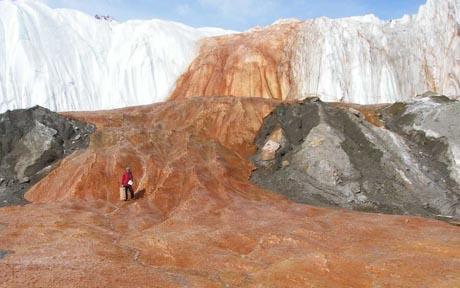
© AP Iron oxides stain the snout of the Taylor Glacier in Antarctica
An ancient colony of microbes thriving without oxygen, warmth or light beneath a rusty glacier has led scientists to re-evaluate what it takes for life to survive.
The bugs, believed to be descended from ocean-dwelling organisms, have evolved a unique ecosystem in a briny pool under 400 meters of ice.
There they have flourished for at least 1.5 million years, transforming sulfur and iron compounds to fuel their growth.
Scientists believe they can shed light on the survival of early life on Earth, or how it might exist on other planets.
Professor Ann Pearson, from Harvard University in Boston, US, said: "It's a bit like finding a forest that nobody has seen for 1.5 million years. Intriguingly, the species living there are similar to contemporary organisms, and yet quite different - a result, no doubt, of having lived in such an inhospitable environment for so long."
The microbes' home is deep below the Taylor Glacier, a giant slab of ice in the McMurdo Dry Valleys of Antarctica, one of the world's harshest environments.
Scientists discovered the bugs in water samples taken from Blood Falls, where bright red minerals spill out of one end of the glacier.
It used to be thought red algae were responsible for the unusual feature, but scientists later learned the color was due to rust.
The source of the "Falls" was found to be an iron-rich pool under the glacier, probably less than three miles wide.
Analysis of the water samples revealed a complete lack of oxygen but high levels of sulfur, a geochemical signature of marine environments.
The researchers think the microbes began life in the ocean, becoming stranded in an isolated pool when sea levels fell more than 1.5 million years ago. Eventually, the pool was capped by the advancing glacier.
A report on the discovery appears in the journal
Science.
Co-author Dr Jill Mikucki, from Dartmouth College in Hanover, New Hampshire, US, said: "This briny pond is a unique sort of time capsule from a period in Earth's history. I don't know of any other environment quite like this on Earth."
Learning how the microbes survived may help scientists address questions about "Snowball Earth", a controversial theory that supposes the Earth was almost entirely covered in ice more than 600 million years ago. Nearly all life would have been wiped out during this period. But the big freeze may also have triggered the evolution of the first complex life-forms on Earth, according to the theory.
The Blood Falls bugs could also provide a model for possible life in extreme environments on other planets, such as below the Martian ice caps or in the ice-covered oceans of Jupiter's moon Europa.

Reader Comments
to our Newsletter